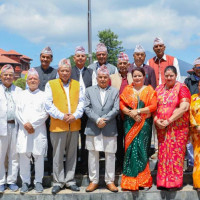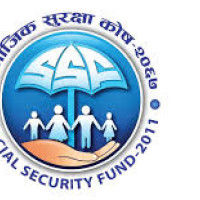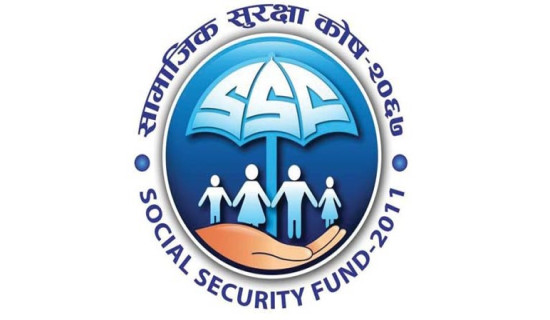- Friday, 25 July 2025
Initiative To Promote Geriatric Healthcare
The demographic landscape of the world is undergoing a profound transformation, with the global population steadily ageing. This significant demographic shift has far-reaching implications across various spheres of society, including work dynamics, financial systems, service provision, and social support structures. Nepal, like many other countries, is witnessing the effects of this trend, and the 2021 Population Census sheds light on the extent of this phenomenon. The census data reveals that a substantial portion, approximately 10.21 per cent (equivalent to 2,977,318 individuals), of Nepal's population falls within the age range of 60 years and above. This ageing trajectory has profound consequences, particularly in terms of health-related challenges, such as heart disease, respiratory ailments, diabetes, and hypertension, among the elderly population in Nepal.
In response to this evolving demographic landscape, it becomes imperative to outline priority areas and activities that address the specific needs of the elderly population. A commitment to healthy ageing stands as a fundamental pillar in this endeavour. Aligning health systems with the unique requirements of older demographics, developing comprehensive long-term care systems, establishing age-friendly environments, and enhancing measurement, monitoring, and understanding of elderly health become critical strategies to ensure the well-being of this segment of the population. Framing these initiatives within the broader context of global development, the Sustainable Development Goals (SDGs) emphasise the universal pursuit of health and well-being throughout all stages of life. The primary objective revolves around achieving universal health coverage and ensuring equitable access to safe, effective, and affordable medicines and vaccines. Nepal's National Health Policy of 2019 further reinforces this commitment, highlighting the development and expansion of health services tailored to senior citizens within a comprehensive life cycle approach.
Nepal has instituted a series of legislative and policy measures that echo the nation's dedication to elderly welfare. The constitution enshrines the right to health for every citizen, ensuring access to basic health services, including emergency care. The Senior Citizen Act of 2006 underscores the responsibility of all to provide essential services, facilities, and assistance to elderly citizens, particularly medical services. Notably, this act places a strong emphasis on the health needs of senior citizens, mandating that organisations offering health services prioritise their requirements. Moreover, the act ensures that designated government-specified health service providers extend a minimum of 50 per cent treatment fee concessions to senior citizens.
In line with the spirit of these legislative foundations, Nepal's Ministry of Health and Population (MoHP) has embarked on a journey to enhance services tailored to senior citizens.
A pivotal step in this direction has been the establishment of dedicated geriatric wards within hospitals. The MoHP's initiatives, guided by the Geriatric (Senior Citizens) Health Service Establishment and Operation Guidelines of 2077 (2020/21), have led to the expansion of such services from a mere eight referral hospitals to an impressive 62 hospitals as of the current fiscal year 2022/23 (2080/81).
The overarching vision encompasses the transformation of entire hospitals into geriatric-friendly and responsive entities, ultimately providing accessible and holistic healthcare to elderly citizens.
These guidelines incorporate a vital provision that offers a 50 per cent discount on specific health services to senior citizens aged 60 years and older, ensuring that financial considerations do not hinder their access to essential medical care. The discount structure is tailored to different age groups, with individuals aged 60 to 69 receiving a 50 per cent concession on select services. Those within the age groups of 70–79 and 80–84 is entitled to discounts of 75 per cent and 100 per cent, respectively, based on factors such as incompetency, chronic illnesses, and economic status. Notably, individuals aged 85 and above are granted a comprehensive 100 per cent concession on all health services offered by hospitals. These measures collectively aim to streamline healthcare access, promote wellness, and foster age-friendly infrastructure within hospitals.
The year 2021/22 witnessed a collaborative effort between the MoHP and the Nepal Health Research Council to conduct a comprehensive study titled "Assessment on Feasibility and Implementation Status of Geriatric Health Service at Selected Hospitals of Nepal." The study sought to evaluate the actual progress of service implementation, identify obstacles and challenges encountered, and shed light on areas for improvement. The assessment encompassed an evaluation of programme implementation by various institutions, an appraisal of the readiness of health institutes offering the service, and the identification of prospective institutions considering its initiation.
The findings of this study underscore a series of challenges that warrant attention. These include budgetary constraints, an inadequacy of skilled or trained personnel, and infrastructural limitations that hinder the seamless delivery of geriatric health services. To address these hurdles, a holistic approach is recommended. This entails stakeholder involvement in programme design, feasibility studies to ascertain resource availability and suitability, and robust public awareness campaigns conducted at the grassroots level. Local-level health workers, such as Female Community Health Volunteers (FCHVs), local social organisations, mass media, and social networks, can play a pivotal role in disseminating information and fostering understanding.
The study further delved into patient perspectives and satisfaction levels, revealing a positive correlation between the utilisation of health insurance and geriatric health services and contentment with the adequacy, accessibility, and availability of care. Building upon these insights, recommendations were formulated to strengthen the service's impact.
These include the development of a comprehensive single-door health information management system for data transparency and accessibility, an integrated approach to health insurance to streamline elderly-focused initiatives, and the establishment of an umbrella framework to replace fragmented programmes.
In conclusion, Nepal's response to the challenges and opportunities posed by an ageing population is rooted in a multi-faceted approach that draws upon legislative provisions, policy frameworks, and targeted interventions. The nation's commitment to promoting healthy ageing, coupled with the strategic expansion of geriatric health services, exemplifies a proactive stance.
However, the journey ahead requires concerted efforts to enhance public awareness, optimise hospital infrastructure, and fine-tune support mechanisms.
(Karmacharya is a Senior Community Nursing Officer at the Ministry of Health and Population.)



-original-thumb.jpg)


-original-thumb.jpg)










